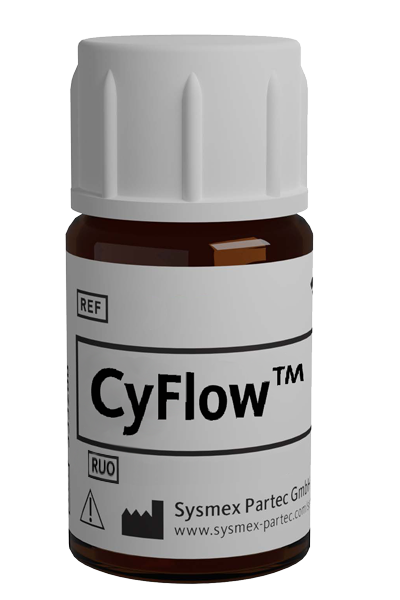CyFlow™ MHCII FITC

| Antibody: | Yes |
| Antigen: | MHC Class II |
| Application: | Flow cytometry |
| Clonality: | monoclonal |
| Clone: | M5/114 |
| Emission Maximum: | 518 nm |
| Excitation Maximum: | 490 to 495 nm |
| Field of Interest: | Immunophenotyping, MHC |
| Format/Fluorochrome: | FITC |
| Isotype: | IgG2b |
| Laser: | Blue |
| Regulatory Status: | RUO |
| Source Species: | Rat |
| Target Species: | Mouse |
| Product number: | BJ649436 |
For Research Use Only
| Concentration Unit | mg/mL |
| Concentration | 0,5 |
| Quantity | 0.1 mg |
| Volume | 0.2 mL |
| Immunogen | Activated C57BL/6 mouse spleen cells |
| Background Information | MHC (major histocompatibility complex) class II (MHCII) molecules are transmembrane glycoproteins expressed on the surface of professional antigen-presenting cells, such as macrophages, dendritic cells and B cells. Before their exposition on the cell surface, the MHC class II molecules react with endocytosed exogenous antigens, which are then presented to the T cells. The antigen-binding groove between MHC class II α and β chain is open at both ends and is 15-24 amino acid residues long. |
| Usage | The reagent is designed for Flow Cytometry analysis. Suggested working usage is 4·µg/ml. Indicated dilution is recommended starting point for use of this product, but working concentrations should be validated by the investigator. |
| Storage Buffer | The reagent is provided in phosphate buffered saline (PBS) solution, pH ≈7.4, containing 0.09% (w/v) sodium azide. |
| Storage | Avoid prolonged exposure to light. Store in the dark at 2-8°C. Do not freeze. |
| Stability | Do not use after expiration date stamped on vial label. |
| Bhattacharya A, Dorf ME, Springer TA: A shared alloantigenic determinant on Ia antigens encoded by the I‑A and I‑E subregions: evidence for I region gene duplication. J Immunol. 1981 Dec; 127(6):2488‑95. < PMID: 6170707 > | Viville S, Neefjes J, Lotteau V, Dierich A, Lemeur M, Ploegh H, Benoist C, Mathis D: Mice lacking the MHC class II‑associated invariant chain. Cell. 1993 Feb 26; 72(4):635‑48. < PMID: 7679955 > | De Souza Leao S, Lang T, Prina E, Hellio R, Antoine JC: Intracellular Leishmania amazonensis amastigotes internalize and degrade MHC class II molecules of their host cells. J Cell Sci. 1995 Oct; 108 (10):3219‑31. < PMID: 7593283 > | Clausen BE, Waldburger JM, Schwenk F, Barras E, Mach B, Rajewsky K, Förster I, Reith W: Residual MHC class II expression on mature dendritic cells and activated B cells in RFX5‑deficient mice. Immunity. 1998 Feb; 8(2):143‑55. < PMID: 9491996 > | Kleijmeer M, Ramm G, Schuurhuis D, Griffith J, Rescigno M, Ricciardi-Castagnoli P, Rudensky AY, Ossendorp F, Melief CJ, Stoorvogel W, Geuze HJ: Reorganization of multivesicular bodies regulates MHC class II antigen presentation by dendritic cells. J Cell Biol. 2001 Oct 1; 155(1):53‑63. < PMID: 11581285 > | Beers C, Burich A, Kleijmeer MJ, Griffith JM, Wong P, Rudensky AY: Cathepsin S controls MHC class II‑mediated antigen presentation by epithelial cells in vivo. J Immunol. 2005 Feb 1; 174(3):1205‑12. < PMID: 15661874 > | Zang W, Kalache S, Lin M, Schroppel B, Murphy B: MHC Class II‑mediated apoptosis by a nonpolymorphic MHC Class II peptide proceeds by activation of protein kinase C. J Am Soc Nephrol. 2005 Dec; 16(12):3661‑8. < PMID: 16221866 > | Kuwano Y, Prazma CM, Yazawa N, Watanabe R, Ishiura N, Kumanogoh A, Okochi H, Tamaki K, Fujimoto M, Tedder TF: CD83 influences cell‑surface MHC class II expression on B cells and other antigen‑presenting cells. Int Immunol. 2007 Aug; 19(8):977‑92. < PMID: 17804692 >
